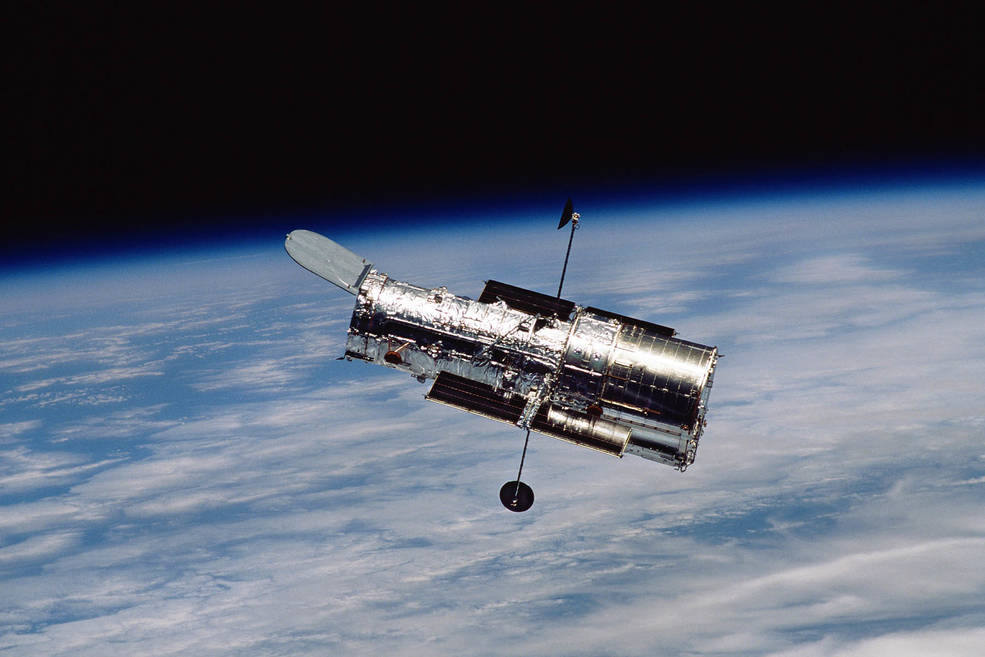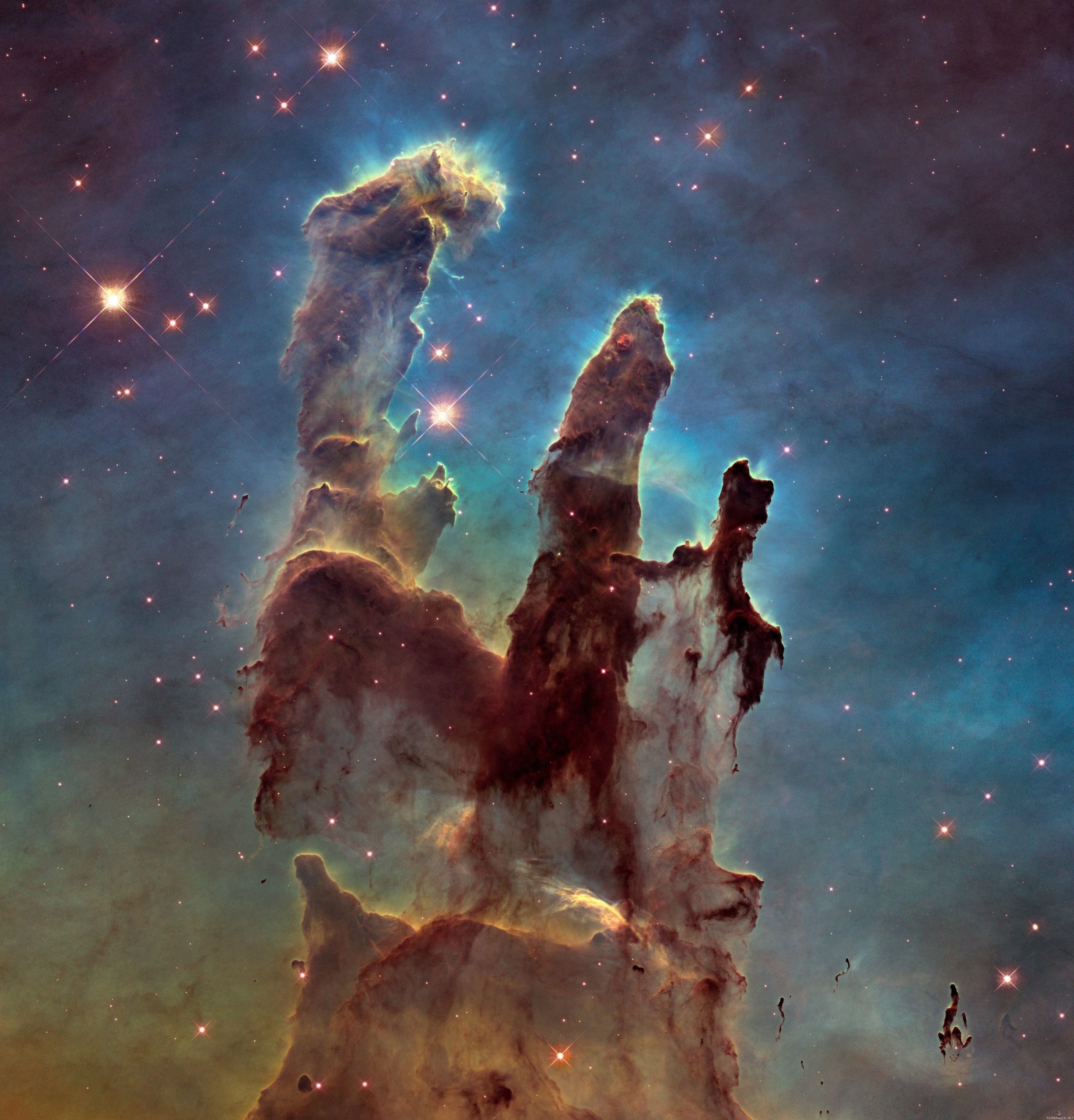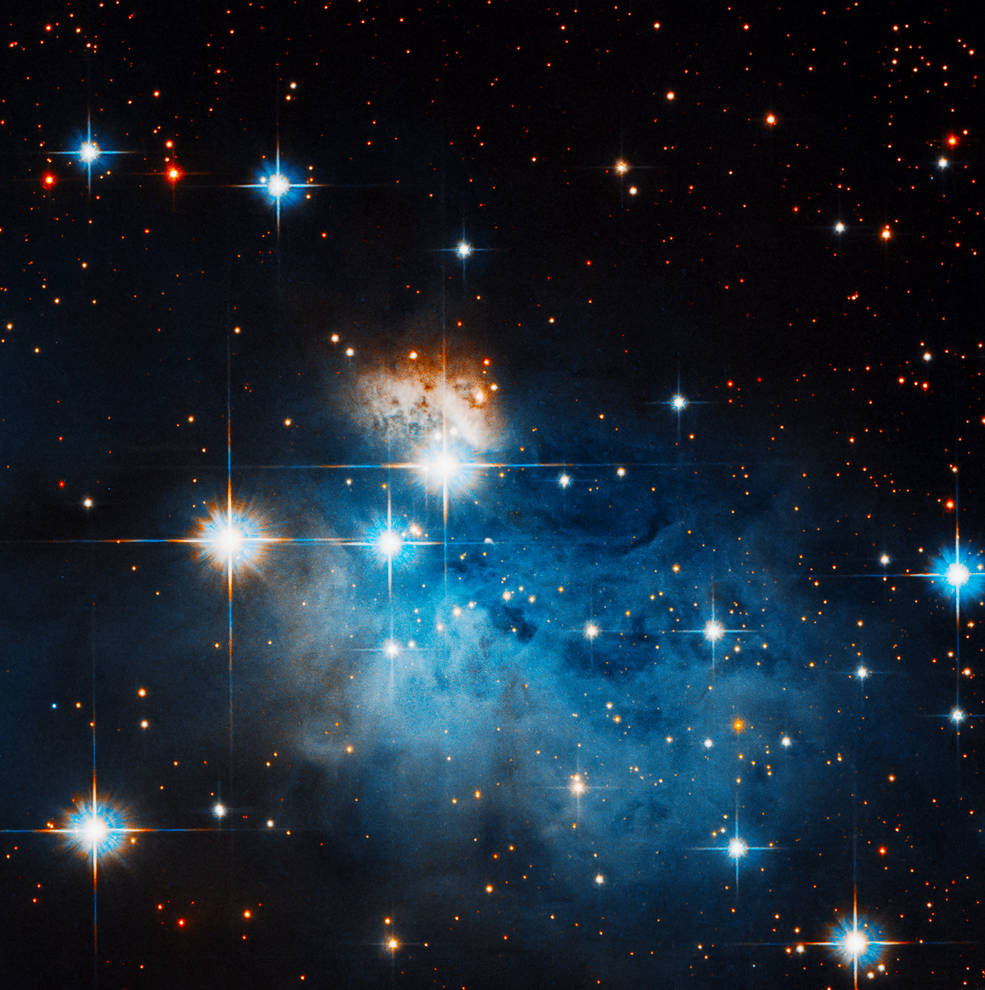The Hubble Space Telescope changed our understanding of the Universe, and its view from orbit triggered a flood of cosmic
 Telescope in 2002. Photo: NASA
Telescope in 2002. Photo: NASA
Why send a telescope into space?
Hubble was designed as an observatory for the generaldestination intended for the study of the universe in the visible, ultraviolet and infrared wavelengths. To date, the telescope has studied over 40,000 space objects, providing views that astronomers have not been able to capture from Earth.
Besides the fact that the earth's atmosphere is completelyBlocks light of certain wavelengths, it is composed of moving pockets of air that cause twinkling stars in the night sky. This movement blurs images taken with telescopes on the ground. Hubble was launched into orbit above the atmosphere to avoid these effects.
 NGC 3147 - 130 million spiral galaxylight years from Earth. Hubble's clear vision of space allows it to capture details such as clusters of young blue stars, pinkish nebulae, and dust streaks visible in the galaxy's graceful winding arms. Sources: NASANASA, ESA, S. Bianchi (Università degli Studi Roma Tre University), A. Laor (Technion-Israel Institute of Technology) and M. Chiaberge (ESA, STScI and JHU)
NGC 3147 - 130 million spiral galaxylight years from Earth. Hubble's clear vision of space allows it to capture details such as clusters of young blue stars, pinkish nebulae, and dust streaks visible in the galaxy's graceful winding arms. Sources: NASANASA, ESA, S. Bianchi (Università degli Studi Roma Tre University), A. Laor (Technion-Israel Institute of Technology) and M. Chiaberge (ESA, STScI and JHU)
Although the Hubble mirror is much smaller thanthe largest ground-based observatories, the unique position of the telescope above the Earth's atmosphere gives it incredible clarity. As the telescope orbits the Earth, its mirror collects light from space, collecting images and data. For some of Hubble's deepest images, the telescope stared at the same point in the sky for several days, trying to capture as much of the faint glow of the distant universe as possible.
Cosmic discoveries
When the Hubble telescope was launched, it wasIt is known that the age of the Universe was 10-20 billion years. By studying a specific class of stars that can be used to determine distance, Hubble was able to help narrow down this broad figure to about 13.8 billion years, a number now used to understand the time scale and development of stars, galaxies and more.
 RS Puppis is a variablea Cepheid star that rhythmically brightens and darkens over time in a predictable manner. Using the known brightness of Cepheid variables, astronomers can determine the distances to these stars. Sources: NASA, ESA and the Hubble Legacy Team (STScI/AURA) Hubble-Europe collaboration
RS Puppis is a variablea Cepheid star that rhythmically brightens and darkens over time in a predictable manner. Using the known brightness of Cepheid variables, astronomers can determine the distances to these stars. Sources: NASA, ESA and the Hubble Legacy Team (STScI/AURA) Hubble-Europe collaboration
Hubble discovered supermassive black holeslurking in the hearts of galaxies, and helped map the presence of elusive dark matter around galaxy clusters. But one of the strangest discoveries was the discovery that the expansion of the Universe is accelerating due to the presence of a still unidentified and previously unknown “dark energy.” With its ability to bring pristine images of the universe back to Earth, Hubble has often shown humanity how much it still has to learn about space.
Hubble time machine
The cosmos is so vast that even lightit takes a long time to travel through the vast space between objects. The light of the Earth's Moon takes about 1.3 light seconds to reach us, so when we look at the Moon in the sky, we see it as it appeared 1.3 seconds ago.
 The Hubble Extreme Deep Field contains 5,500galaxies, including some of them, which are 13.2 billion years old. Authors: NASA, European Space Agency, G. Illingworth, D. Magee and P. Oesch (University of California, Santa Cruz), R. Bowens (University of Leiden) and the HUDF09 team.
The Hubble Extreme Deep Field contains 5,500galaxies, including some of them, which are 13.2 billion years old. Authors: NASA, European Space Agency, G. Illingworth, D. Magee and P. Oesch (University of California, Santa Cruz), R. Bowens (University of Leiden) and the HUDF09 team.
The light of the most distant space objects begantravel in space billions of years ago. When he finally arrives in our corner of the universe, he shows us the universe as it was in the distant past. By capturing the faint light of the early Universe, Hubble can see galaxies as they were billions of years ago, showing us how they developed and evolved over time.
We cannot watch how they changegalaxies or stars—they develop over billions of years. But by looking at them at different stages of their existence, Hubble helped demonstrate how galaxies change and grow as a result of interactions and collisions. He gave us pictures of stars at different stages of stellar life and showed how they merge and ignite in clouds of gas and dust, exhale outer layers in the form of nebulae and explode as supernovae.
The planets of the solar system
Hubble was used to research everything:from the weather on the planets in our solar system to the birth of planets around other stars. He studied the composition of the atmospheres of these extrasolar planets or exoplanets and may have obtained one of the first images of such a planet in visible light.
 In this image of Jupiter takenThe Hubble telescope shows the Great Red Spot on the gas giant planet - a huge storm raging in the planet's atmosphere. Authors: NASA, ESA, A. Simon (Goddard Space Flight Center) and M. H. Wong (University of California, Berkeley).
In this image of Jupiter takenThe Hubble telescope shows the Great Red Spot on the gas giant planet - a huge storm raging in the planet's atmosphere. Authors: NASA, ESA, A. Simon (Goddard Space Flight Center) and M. H. Wong (University of California, Berkeley).
Hubble became an important witness to eventsin our solar system—he observed collisions of comets and asteroids with Jupiter, storms and auroras on neighboring planets, disintegrating asteroids and passing comets. Our cosmic backyard continues to offer many surprises: Hubble was the first to discover rings and moons around Uranus and moons around Pluto. Thanks to Hubble, we have a much better understanding of what our solar system actually looks like and how it works.
How did Hubble's discoveries affect humanity?
In 1609, observations of an Italian scientistGalileo Galilei finally showed that there are celestial bodies (the moons of Jupiter) that do not revolve around the Earth. This revolutionary discovery forever changed our understanding of the Universe with its center at the center of the Earth.
A new revolution in astronomy
Almost four centuries later, the launch of spaceNASA's Hubble Telescope aboard the Discovery spacecraft in 1990 marked the beginning of a new revolution in astronomy. Created as a partnership between the US space program and the European Space Agency, Hubble orbits 547 km above the Earth's surface. This vantage point allows Hubble to observe astronomical objects and phenomena more consistently and in greater detail than is typically possible from ground-based observatories. Over 30 years, Hubble observations have played a key role in the discovery and characterization of the mysterious dark energy that appears to permeate all space in the Universe. Results like these have changed our fundamental understanding of the cosmos.
 All communications with Hubble take place inThe Mission Operations Room, where engineers submit weekly observation plans, monitor the health and safety of the Hubble and eliminate any anomalies that arise.
All communications with Hubble take place inThe Mission Operations Room, where engineers submit weekly observation plans, monitor the health and safety of the Hubble and eliminate any anomalies that arise.
Photo: NASA
Impact on the scientific community
During the third decadeHubble continues to be extremely productive. The orbiting telescope has made more than a million observations and provided data that astronomers have used to write more than 17,000 peer-reviewed scientific publications on a wide range of topics, from planet formation to giant black holes. These documents have been cited in other publications approximately 900,000 times, and this total is increasing by an average of 150 per day. Every current textbook on astronomy includes observatory materials. Today's college students have never known a time in their lives when astronomers weren't actively making discoveries using Hubble data.
Popularization of astronomy
Hubble discoveries and memorable photographsalso revived public interest in astronomy. Along with images of the telescope and the astronauts who launched and maintained it during six space shuttle missions, some memorable scientific images have become cultural icons. They regularly appear on book covers, music albums, clothing, television shows, films and even church stained glass windows.
 One of the most famous images of the telescopeHubble is part of the Eagle Nebula (M16). Called the Pillars of Creation, it shows three huge pillars of cold gas illuminated by the light of a cluster of young stars with strong stellar winds out of sight above. The tips of the finger-like protrusions at the top of the columns contain dense gaseous globules, within which stars are born. The largest of the three pillars is about four light-years tall.
One of the most famous images of the telescopeHubble is part of the Eagle Nebula (M16). Called the Pillars of Creation, it shows three huge pillars of cold gas illuminated by the light of a cluster of young stars with strong stellar winds out of sight above. The tips of the finger-like protrusions at the top of the columns contain dense gaseous globules, within which stars are born. The largest of the three pillars is about four light-years tall.
Photo: NASA / ESA / STScI / Arizona State University
Science of the future
Thanks to its unique design, whichallowing it to be maintained in orbit by astronauts, Hubble was periodically repaired and updated using advanced tools. Now at the peak of its capabilities, Hubble continues to expand the boundaries of our cosmic knowledge. With a history of unprecedented discoveries, there are even more mysteries to unravel, and more revelations still to come—each of which opens our eyes a little more to the wonders that exist in the near and far corners of the universe. brought to us by a telescope that allows us to see humanity beyond the boundaries of the Earth.
Gift for Hubble's thirtieth anniversary
NASA recently released dozens of recentlyProcessed images from the Hubble Telescope show 30 dazzling galaxies, sparkling star clusters and ethereal nebulae. Remarkably, these 30 celestial objects are visible through backyard telescopes. Some of them can also be seen with binoculars or even with the naked eye. But, of course, Hubble can see them much better.
 This telescope image captures a sphericalStar Cluster Caldwell 78 (or NGC 6541) is about 22,000 light-years from Earth. The cluster is bright enough for backyard astronomers in the Southern Hemisphere to spot easily through binoculars.
This telescope image captures a sphericalStar Cluster Caldwell 78 (or NGC 6541) is about 22,000 light-years from Earth. The cluster is bright enough for backyard astronomers in the Southern Hemisphere to spot easily through binoculars.
Sources: NASA, European Space Agency and J. Piotto (University of Padua); Processing: Gladys Kober
All these celestial objects belong to the collection,known to amateur astronomers as the Caldwell catalogue. The catalog, compiled by British amateur astronomer and science communicator Sir Patrick Caldwell-Moore, was published by Sky & Telescope 25 years ago, in December 1995. It was inspired by the Messier catalog compiled by French comet hunter Charles Messier, which includes 110 relatively bright but faint objects in the Northern Hemisphere sky that could be accidentally mistaken for comets. The Caldwell catalog identifies 109 galaxies, star clusters and nebulae that are not included in the Messier catalog but are also bright enough to be seen by amateur astronomers. In addition, Caldwell objects are divided between the skies of the northern and southern hemispheres, providing interesting targets for amateur astronomers around the world.

Today Hubble has two main camerasfor space photography. Called the Advanced Camera for Surveys (ACS) and the Wide Field Camera 3 (WFC3), they work together to provide superior wide-field imaging over a wide range of wavelengths. Telescope observations in visible light allow us to see cosmic objects in the same wavelengths of light that we see with our own eyes, but with a much greater level of detail. Infrared observations expand our vision, detecting light with less energy than our eyes can see and peering through veils of dust to image some of the faintest and most distant objects ever detected. Hubble's ultraviolet vision extends the view in the opposite direction, opening a window into the evolving Universe and allowing us to see some of the most violent events in space.
While Hubble providesImaged in exquisite detail, Caldwell's objects can be observed using modest ground-based telescopes, although some are more challenging targets than others. There are many deep sky objects in the catalog that are bright enough to be seen with binoculars, and some that are visible to the naked eye. Regardless of the observing instrument, Caldwell sites are rich in history, full of science and interesting to observe.
This newly released collection of more than 50 Hubble images includes 30 objects in the Caldwell catalog.These images were taken by Hubble throughout its career and used for scientific research or engineering testing, but NASA hasn't fully processed the images for public release until now.

Use the link to view the Hubble Caldwell catalog on a map.
The editors of Hi-Tech selected the most impressive photographs from the latest ones published.






Read also
20 new species of animals and plants found in the Andes
There are highways in space for fast travel. How will flights change?
Named a plant that is not afraid of climate change. It feeds a billion people